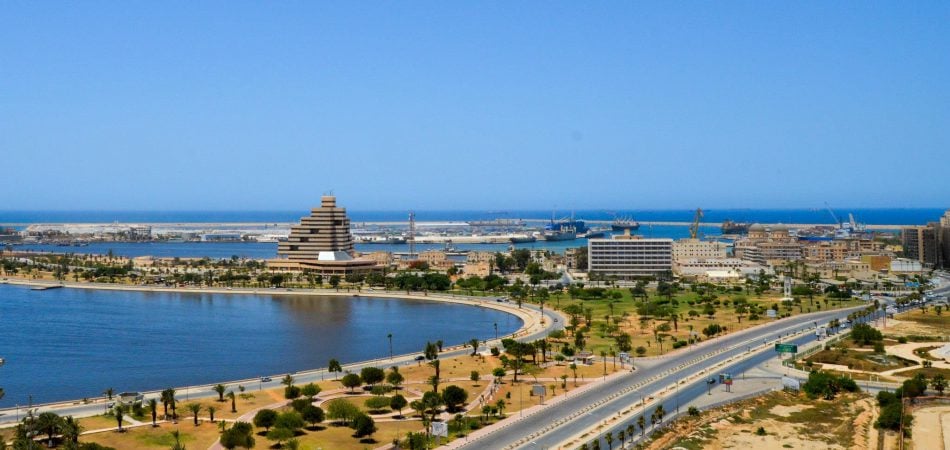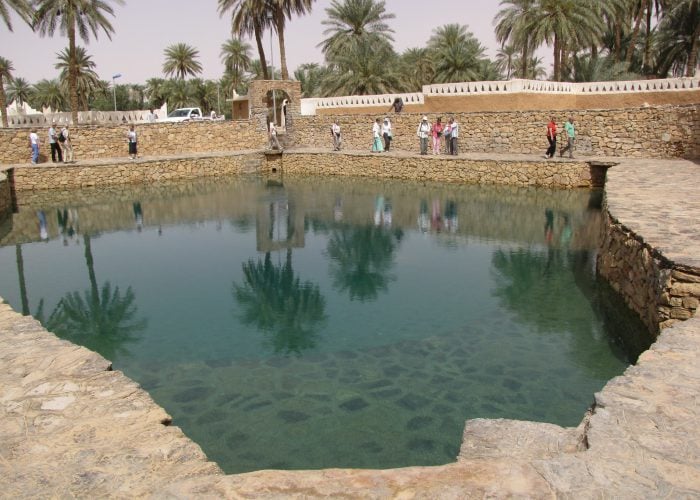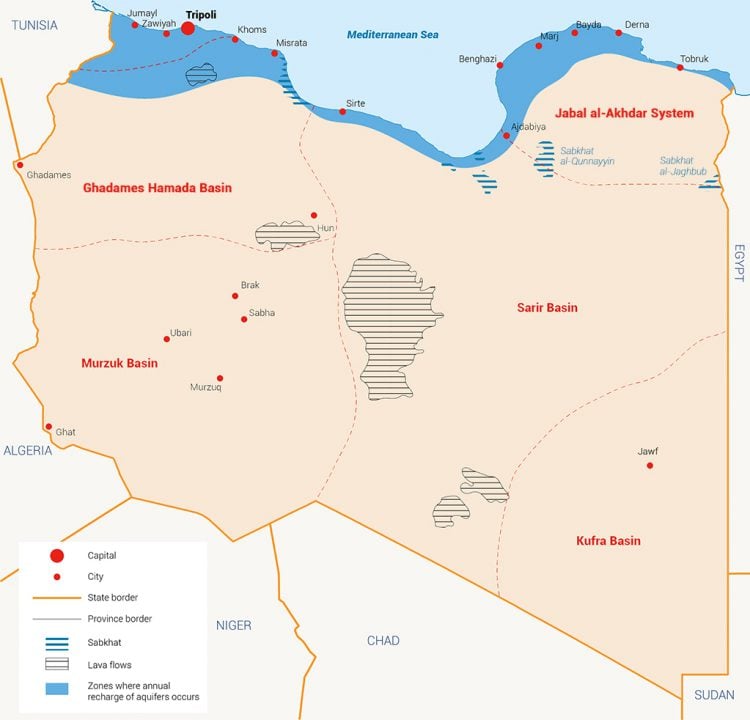
Surface water
Libya has no rivers, and its surface run-off is limited to short floods following extreme rainstorms in the winter. This puts the total contribution of surface water at less than 3% of the existing water in use.[1] Therefore, and according to the present conditions surface water resources do not add very much to Libya’s water supply. To control these intermittent resources in the wadis, 18 dams were constructed to collect around 61million cubic metres (MCM) of run-off water.[2]
Natural springs in Jabal al-Akhdar, Jabal Nafusa and several places in central Libya are another source of surface run-off. Their discharge varies from 1litre per second (L/s) to over 10L/s, supplying different uses.[3] Rehabilitation of several springs has been carried out, including Ain al-Faras in western Libya (Photos 2), to optimize their contribution to freshwater supply.[4]

Normal springs have discharge with good quality (Table 1-2).[5] Several, namely Ain Zayana(flow 5,580 L/s), Ain Kaam(flow 350 L/s), Ain Dabbousia(flow 170-230 L/s) and Ain Tawargha (flow 2,000 L/s), are characterized by their high discharge values.[6]
The reservoir of the 18 dams that were constructed largely in the north of the country was designed to add 390 MCM of annual storage capacity. However, because of the watershed climatic conditions of some dams, this amount has decreased to 60-70 MCM/yr.[7]
Table 1: The main springs in Gefara Plain, Nafusa and Hamada, Libya with their flow rates and quality.[9]
| No. | Location | Flow L/s | TDS, mg/L |
| 1 | Rabta | 8 | 1,440 |
| 2 | Rabta | 6 | 1,200 |
| 3 | Gheraan | 5-7 | 900 |
| 4 | Gheraan | 7 | 2,500 |
| 5 | Gheraan | 5-7 | 950 |
| 6 | Zarat | 8 | 1,300 |
| 7 | Trhouna | 7 | 1,100 |
| 8 | Tawargha | 2,000 | 3,000 |
| 9 | Wadi Ekaam | 350 | 1,400-2,000 |
| 10 | Al Hesh | 151 | 2,000-3,000 |
| Total spring discharge | 2,549 L/s |
Groundwater
Libya depends heavily on groundwater, which accounts for more than 97% of the water used.[10]In the past, groundwater was extracted from large-diameter dug wells using traditional tools, as water levels were close to the surface. During the oil boom in the early 1960s, groundwater withdrawal increased rapidly, leading to the use of centrifugal and submersible pumps to manage the falling water table.[11] Six basins were identified for groundwater exploitation in accordance with their different physiographical, geological, structural and hydrogeological characteristics (Map 1).[12]Ground water resources in these basins were also classified into two types according to their sources: renewable and non-renewable.[13]
Table 2: The main springs in Jabal al-Akhdar with their flow rates and quality.[8]
| No. | Location | Flow L/s | TDS, mg/L |
| 1 | Ras hlal | 9.8 | 700 |
| 2 | Derna | 5 | 800 |
| 3 | Ras halal | 5.8 | 670 |
| 4 | Sousa | 5 | 805 |
| 5 | Derna | 100-150 | 500 |
| 6 | Derna | 60 | 520 |
| 7 | Ghoba | 170-230 | 600 |
| 8 | Shaat | 6 | 450 |
| 9 | Wadi Nagha | 9-24 | 700 |
| 10 | Wadi Nagha | 15 | - |
| 11 | Wadi Bashara | 15 | - |
| 12 | Wadi Aneal | 5 | - |
| 13 | Ghoba | 4-15 | - |
| 14 | Wadi Bashara | 20 | - |
| 15 | Tobruk | 12 | 7,800 |
| 16 | Wadi Bashara | 18 | - |
| 17 | Benghazi | 5,580 | 16,000 |
| 18 | Bada | 5 | - |
| 19 | Shaat | 6 | - |
| Total spring discharge | 6,118.6 L/s |
Renewable basins are found in the north (Gefara Plain, Jabal al-Akhdar and part of Hamada al-Hamra), while the other sedimentary basins (Murzuk, Kufra and Sarir) containing non-renewable groundwater are found in the south. Renewable groundwater is estimated to be 600-650 MCM/yr.[14] Other places that have local recharge because of rare heavy rain producing run-off have been observed in the Haruj Mountains in the centre of the country, in the Tibesti Mountains in the south and the Aweinat Mountains in the west. The recharge amount in these areas is minor and has little value compared to the storage values and aquifer losses.[15]
Non-conventional water resources
Desalination
Desalination has been used in Libya since the early 1960s as an important source of non-conventional water.[16]Two technologies (thermal and membrane) were implemented to bridge the gap between water availability and industrial demand.[17] Currently, there are 21 desalination plants operated by different authorities (Table 3), even though all of them are owned by the government. The General Electricity Company of Libya, General Desalination Company (GDC) and General Company for Water and Wastewater (GCWW) are the responsible authorities for the desalination plants.[18]The plants have a total design capacity of 525,680 cubic metres per day (m3/d), and the amount of desalinated water produced in 2010 was 71 MCM, according to data obtained from the GDC.[19]
Although desalination is becoming a solution for water scarcity in most arid countries, the Libyan government has not adopted desalination as a strategic option.
Table 3: Operating desalination plantsin Libya.[20]
| Location | Desalination type | Design capacity m3/d | No of Units | Operation year |
| Tobruk | MED *-TVC ** | 40,000 | - | 1977-2002 |
| Bomba | MSF *** | 30,000 | 3 | 1988 |
| Derna | MED-TVC | 40,000 | - | - |
| Sussa | MED-TVC | 10,000 | 2 | 2000 |
| Sussa ext. | MED-TVC | 40,000 | - | - |
| Abou Traba | MED-TVC | 40,000 | - | 2006 |
| Zliten | MSF | 30,000 | 3 | 1992 |
| Azawia | MED-TVC | 80,000 | - | - |
| Zwara | MED | 40,000 | - | 2006 |
| Zwara ext. | MED-TVC | 40,000 | - | - |
| Tubrok | MSF | 24,000 | 4 | 1977 |
| Tajoura | RO **** | 10,000 | 2 | 1984 |
| Misrata | MSF | 30,000 | 3 | 1987 |
| Sirte | MSF | 10,000 | 1 | 1986 |
| Azawia double | MED | 2,500 x 2 | 2 | 2006 |
| Tripoli west | MED-TVC | 5,000 x 2 | 2 | 1999 |
| Homes | MSF | 10,560 x 3 | 4 | 1985 |
| Benghazi north | MED-TVC | 4,800 x 1 | 1 | 2005 |
| Benghazi north double | MED-TVC | 2,500 x 2 | 2 | 2007 |
| Derna | MED-TVC | 4,700 x 1 | 1 | 1998 |
| Hrawa | MSF | 500 x 1 | 1 | 1989 |
| Total design capacity | 525,680 |
Treated wastewater
Wastewater treatment plants (WWTPs) are another important non-conventional water resource. Libya has built more than 75 WWTPs, with design capacities exceeding 450,000 m3/d.[21] The effluent quantities utilized for irrigation are currently very small because of technical and non-technical problems.[22] In Libya, there is a crucial need for integrated water resources management in the form of reuse of effluent water as an alternative to conventional water supply.[23] The water produced by WWTPs is designed for agricultural use only.[24]Two agricultural projects (of 6,000 hectares) were shown to benefit from water produced by WWTPs established in Tripoli and Benghazi (Table 4).[25]
Table 4: The two main wastewater treatment plants in Tripoli and Benghazi irrigating two agricultural projects.[26]
| Project location | Storage | Discharge (m3/day) | Irrigation (hectares) | Irrigated crops |
| Tripoli | 1st stage | 27,000 | 2,500 | Fruit trees and animal fodder |
| 2nd stage | 110,000 | 1,500 | animal fodder | |
| Benghazi | 1st stage | 27,000 | 360 | animal fodder |
| 2nd stage | 27,000 | 658 | animal fodder | |
| 3rd stage | 27,000 | 1,000 | animal fodder |
According to the GCWW, private sector participation in the construction of water supply and sanitation projects is limited. In addition, operation and maintenance of the water supply and sanitation sector is performed entirely by the public sector, although it is hoped that this will change to allow more private sector involvement.[27] Public awareness programmes are also required to promote wastewater reuse.
Water harvesting projects are rare, although there is a great need to expand such projects as a tool to meet the current water demand. Between 2009 and 2014, Libya carried out a study to determine the social, economic, technical and financial feasibility of water harvesting in Jabal al-Akhdar as a means to increase and stabilize agricultural production.[28] A few small water harvesting projects (not planned) have been implemented in the mountainous areas by private sector actors.
Total water availability and per capita availability
The water balance in Libya is limited to precipitation and groundwater abstractions. Since groundwater resources are mostly fossil in nature, the safe yield should not exceed the estimated freshwater resources, which are about 3,650 MCM/yr. The water budget given here, based on data from different studies, is as follows:
Surface water collected from seasonal run-off behind dams = 170 MCM/yr.[29]
Desalinated water as per 2012 = 70 MCM/yr.[30]
Sustainable groundwater abstraction should not exceed 3,650 MCM/yr.[31] This amount covers renewable groundwater = 650 MCM/yr; fossil water from Gefara Plain = 25 MCM/yr; fossil water from Jabal al-Akhdar = 25 MCM/yr; fossil water from Hamada = 150 MCM/yr; fossil water from Murzuk = 1,500 MCM/yr; and fossil water from Kufra and Sarir = 1,300 MCM/yr.
Accordingly, the estimated water resources for Libya = 3,890 MCM/yr.
Based on data available to 2012,[32] water use is estimated to be 5,830 MCM/yr (83% for agriculture, 12% for domestic use and 5% for the industrial sector).[33]This is a deficit of 1,940 MCM/yr.
Rainfed agriculture abstraction is estimated at 2,350 MCM/yr.[34]
Table 5 summarizes Libya’s water budget, based on data available to 2012. However, uncertainties in groundwater abstraction as a result of unlicensed wells, green water and wastewater reuse likely contributed to the balance.
Table 5: Libya’s water budget in 2012.[37]
| Water resources | Quantity (MCM/yr) | Sector | Water consumption MCM/yr |
| Groundwater (Gefara Plain, Jabal al-Akhdr, Kufra, Murzuk, Sarir, Hamada) | 3,650 (3,000 non-renewable, 650 renewable) | Agriculture | 4,850(83%) |
| Surface water (dams, springs) | 170 | Industry | 280 (5%) |
| Desalination | 70 | Domestic | 700 (12%) |
| Green water estimate | 2,350 | ||
| Total | 6,240 | Total | 5,830 |
The projected water balance to 2025 is presented in Table 6. The supply and demand values are conservative because they represent a state of self-sufficiency in basic food production.[35] The projected renewable water resources per capita (Figure 1) show a decrease from 170 m3 in 1995 to 70 m3 in 2025.[36]
Table 6: Libya’s projected water balance(1995-2025).[38]
| Year | 1995 | 2000 | 2005 | 2010 | 2015 | 2020 |
| Supply (MCM) | 3,820 | 3,820 | 3,820 | 3,820 | 3,820 | 3,820 |
| Demand (MCM) | 3,885 | 4,493 | 5,128 | 5,794 | 6,495 | 7,236 |
| Balance (MCM) | -65 | -673 | -1,308 | -1,974 | -2,675 | -3,416 |
[1] General Water Authority , 2014 , Water and Energy for Life in Libya (WELL) , Project funded by the European Commission No. 295143, FP7, Libya.
[2] Ibid.
[3] Ibid.
[4] CEDARE, 2014.Libya Water Sector M&E Rapid Assessment Report. Monitoring and Evaluation for Water in North Africa (MEWINA) project, Water Resources Management Program, CEDARE.
[5] General Water Authority , 2014 , Water and Energy for Life in Libya (WELL) , Project funded by the European Commission No. 295143, FP7, Libya.
[6] AWC, Arab Water Council and CEDARE, 2013. Second State of the Water Report (Draft). Arab Water Council Steering Committee meeting, 26-28 February, 2013.
[7] General Water Authority , 2014 , Water and Energy for Life in Libya (WELL) , Project funded by the European Commission No. 295143, FP7, Libya.
[8] CEDARE, 2014.Libya Water Sector M&E Rapid Assessment Report. Monitoring and Evaluation for Water in North Africa (MEWINA) project, Water Resources Management Program, CEDARE.
[9] Ibid.
[10] Ibid.
[11] Ibid.
[12] General Water Authority , 2014 , Water and Energy for Life in Libya (WELL) , Project funded by the European Commission No. 295143, FP7, Libya.
[13] CEDARE, 2014.Libya Water Sector M&E Rapid Assessment Report. Monitoring and Evaluation for Water in North Africa (MEWINA) project, Water Resources Management Program, CEDARE.
[14] Brika bashir Brika2018. Water resources and desalination in Libya: A review.Proceedings of the 3EWaS International Conference on Insights on the Water-Energy-Food Nexus, Lefkada Island, Greece, 27-30 J.
[15] CEDARE, 2014.Libya Water Sector M&E Rapid Assessment Report. Monitoring and Evaluation for Water in North Africa (MEWINA) project, Water Resources Management Program, CEDARE.
[16] General Water Authority , 2014 , Water and Energy for Life in Libya (WELL) , Project funded by the European Commission No. 295143, FP7, Libya.
[17] CEDARE, 2014.Libya Water Sector M&E Rapid Assessment Report. Monitoring and Evaluation for Water in North Africa (MEWINA) project, Water Resources Management Program, CEDARE.
[18] Brika bashir Brika2018. Water resources and desalination in Libya: A review.Proceedings of the 3EWaS International Conference on Insights on the Water-Energy-Food Nexus, Lefkada Island, Greece, 27-30 J.
[19] Ibid.
[20] Ibid.
[21] CEDARE, 2014.Libya Water Sector M&E Rapid Assessment Report. Monitoring and Evaluation for Water in North Africa (MEWINA) project, Water Resources Management Program, CEDARE.
[22] Ibid.
[23] General Water Authority , 2014 , Water and Energy for Life in Libya (WELL) , Project funded by the European Commission No. 295143, FP7, Libya.
[24] Brika bashir Brika2018. Water resources and desalination in Libya: A review.Proceedings of the 3EWaS International Conference on Insights on the Water-Energy-Food Nexus, Lefkada Island, Greece, 27-30 J.
[25] General Water Authority , 2014 , Water and Energy for Life in Libya (WELL) , Project funded by the European Commission No. 295143, FP7, Libya.
[26] Ibid.
[27] Ibid.
[28] Islamic Development Bank, 2014. Feasibility of water harvesting project in Jabal al-Akhdar.
[29] General Water Authority, 1999. National Strategy for Integrated Water Resources Management (2000-2025).
[30] CEDARE, 2014.Libya Water Sector M&E Rapid Assessment Report. Monitoring and Evaluation for Water in North Africa (MEWINA) project, Water Resources Management Program, CEDARE.
[31] General Water Authority, 1999. National Strategy for Integrated Water Resources Management (2000-2025).
[32] CEDARE, 2014.Libya Water Sector M&E Rapid Assessment Report. Monitoring and Evaluation for Water in North Africa (MEWINA) project, Water Resources Management Program, CEDARE.
[33] General Water Authority, 1999. National Strategy for Integrated Water Resources Management (2000-2025).
[34] CEDARE, 2014.Libya Water Sector M&E Rapid Assessment Report. Monitoring and Evaluation for Water in North Africa (MEWINA) project, Water Resources Management Program, CEDARE.
[35] General Water Authority , 2014 , Water and Energy for Life in Libya (WELL) , Project funded by the European Commission No. 295143, FP7, Libya.
[36] Ibid.
[37] CEDARE, 2014.Libya Water Sector M&E Rapid Assessment Report. Monitoring and Evaluation for Water in North Africa (MEWINA) project, Water Resources Management Program, CEDARE.
[38] General Water Authority , 2014 , Water and Energy for Life in Libya (WELL) , Project funded by the European Commission No. 295143, FP7, Libya.
[39] Ibid.

